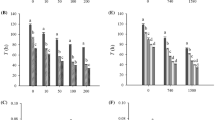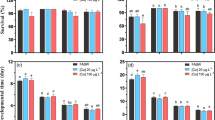Abstract
Cyanobacterial blooms aggravate with increasing temperature, and the increased concentrations of toxicants such as cyanotoxins and nitrite during bloom decay adversely affect the growth of aquatic animals. Heat-shock proteins (Hsps) are induced by a wide range of environmental stressors, including temperature and toxicants. In this study, Brachionus calyciflorus Pallas was exposed to different combined solutions of microcystin-LR (0, 10, 30, and 100 µg L−1) and nitrite (0, 1, 3, and 5 mg L−1) to evaluate their effects on the rotifer lifespan, the reproductive rate (R), and the responses of four Hsp genes at 20 °C, 25 °C, and 30 °C. Results revealed that single high doses of microcystin-LR (100 µg L−1) and nitrite (5 mg L−1) were harmful to the lifespan and reproduction of rotifers. Hormesis was induced by low doses of microcystin-LR (10–30 µg L−1) and nitrite (1–3 mg L−1). At different toxicant concentrations, the expression levels of Hsp40, Hsp60, Hsp70, and Hsp90 fluctuated, whereas reactive oxygen species (ROS) levels increased regardless of temperature. The two toxicants induced high levels of ROS production, which negatively affected the lifespan, R, and Hsp gene expression at 30 °C (p < 0.05). Microcystin-LR and nitrite exerted synergistic effects on the lifespan, R, ROS levels, and Hsp gene expression levels at 20 °C and 25 °C (p < 0.05) but had antagonistic effects on Hsp40 and Hsp60 expression levels at 30 °C (p > 0.05). Temperature, microcystin-LR, and nitrite had interactive effects on the lifespan, R, ROS levels, and Hsp gene expression levels (p < 0.05). The expression levels of Hsp genes are useful biomarkers of high-temperature exposure, and Hsp-mediated heat shock responses are important in microcystin-LR and nitrite stress tolerance of B. calyciflorus.




Similar content being viewed by others
References
ASTM (2001) Standard guide for acute toxicity tests with the rotifer Brachionus. Annual book of ASTM standards, water and environmental technology. Biological effects and environmental fates, vol 1105. American Society for Testing and Materials, West Conshohocken
Berry R, López-Martínez G (2020) A dose of experimental hormesis: when mild stress protects and improves animal performance. Comp Biochem Physiol A Mol Integr Physiol 242:110658
Calabrese EJ (2008) Hormesis: why it is important to toxicology and toxicologists. Environ Toxicol Chem 27:1451–1474
Campos A, Vasconcelos V (2010) Molecular mechanisms of microcystin toxicity in animal cells. Int J Mol Sci 11:268–287
Fan CY, Lee S, Ren HY, Cyr DM (2004) Exchangeable chaperone modules contribute to specification of type I and type II Hsp40 cellular function. Mol Biol Cell 15:761–773
Ger KA, Teh SJ, Goldman CR (2009) Microcystin-LR toxicity on dominant copepods Eurytemora affinis and Pseudodiaptomus forbesi of the upper San Francisco Estuary. Sci Total Environ 407:4852–4857
Ger KA, Urrutia-Cordero P, Frost PC, Hansson LA, Sarnelle O, Wilson AE, Lürling M (2016) The interaction between cyanobacteria and zooplankton in a more eutrophic world. Harmful Algae 54:128–144
Heckmann LH, Connon R, Hutchinson TH, Maund SJ, Sibly RM, Callaghan A (2006) Expression of target and reference genes in Daphnia magna exposed to ibuprofen. BMC Genomics 7:175
Henning-Lucass N, Cordellier M, Streit B, Schwenk K (2016) Phenotypic plasticity in life-history traits of Daphnia galeata in response to temperature—a comparison across clonal lineages separated in time. Ecol Evol 6:881–891
Huang L, Xi Y, Xu X, Wen X (2012) Responses in population growth and reproduction of the freshwater rotifer Brachionus calyciflorus to microcystin-LR at different temperatures. Ann Limnol Int J Lim 48:383–390
Jensen FB (2003) Nitrite disrupts multiple physiological functions in aquatic animals. Comp Biochem Physiol A Mol Integr Physiol 135:9–24
Jiang J, Shi Y, Shan Z, Yang L, Wang X, Shi L (2012) Bioaccumulation, oxidative stress and HSP70 expression in Cyprinus carpio L. exposed to microcystin-LR under laboratory conditions. Comp Biochem Physiol C Toxicol Pharmacol 155:483–490
Jones GJ, Orr PT (1994) Release and degradation of microcystin following algicide treatment of a Microcystis aeruginosa bloom in a recreational lake, as determined by HPLC and protein phosphatase inhibition assay. Water Res 28:871–876
Jung MY, Lee YM (2012) Expression profiles of heat shock protein gene families in the monogonont rotifer Brachionus koreanus—exposed to copper and cadmium. Toxicol Environ Health Sci 4:235–242
Kim BK, Park SK (2020) Phosphatidylserine modulates response to oxidative stress through hormesis and increases lifespan via DAF-16 in Caenorhabditis elegans. Biogerontology 21:231–244
Kim BM, Rhee JS, Jeong CB, Seo JS, Park GS, Lee YM, Lee JS (2014) Heavy metals induce oxidative stress and trigger oxidative stress-mediated heat shock protein (hsp) modulation in the intertidal copepod Tigriopus japonicus. Comp Biochem Physiol C Toxicol Pharmacol 166:65–74
Kroupová HK, Valentová O, Svobodová Z, Šauer P, Máchová J (2016) Toxic effects of nitrite on freshwater organisms: a review. Rev Aquacult 10:1–18
Lahti K, Rapala J, Färdig M, Niemelä M, Sivonen K (1997) Persistence of cyanobacteria hepatotoxin microcystin-LR in particulate material and dissolved in lake water. Water Res 31:1005–1012
Liang Y, Chen X, Lu X, Jin S, Min Y, Yang J (2017) Combined effects of microcystin and nitrite on the growth, lipid peroxidation, and antioxidant responses of the freshwater rotifer Brachionus calyciflorus. Aquat Toxicol 192:78–88
Livak KJ, Schmittgen TD (2001) Analysis of relative gene expression data using real-time quantitative PCR and the 2−ΔΔCt method. Methods 25:402–408
Lürling M, van Oosterhout F, Faassen E (2017) Eutrophication and warming boost cyanobacterial biomass and microcystins. Toxins 9:64
Lyu K, Wang Q, Chen R, Lu Q, Yang Z (2013) Inter-specific differences in survival and reproduction of cladocerans to nitrite gradient and the ecological implications. Biochem Syst Ecol 48:151–156
Lyu K, Zhu X, Chen R, Chen Y, Yang Z (2014) Molecular cloning of manganese superoxide dismutase gene in the cladoceran Daphnia magna: effects of microcystin, nitrite, and cadmium on gene expression profiles. Aquat Toxicol 148:55–64
Lyu K, Meng Q, Zhu X, Dai D, Zhang L, Huang Y, Yang Z (2016) Changes in iTRAQ-based proteomic profiling of the cladoceran Daphnia magna exposed to microcystin-producing and microcystin-free Microcystis aeruginosa. Environ Sci Technol 50:4798–4807
Lyu K, Gu L, Wang H, Zhu X, Zhang L, Sun Y, Huang Y, Yang Z (2018) Transcriptomic analysis dissects the mechanistic insight into the Daphnia clonal variation in tolerance to toxic Microcystis. Limnol Oceanogr 9999:1–12
Mclellan NL, Manderville RA (2017) Toxic mechanisms of microcystins in mammals. Toxicol Res 6:391–405
Mowe MAD, Mitrovic SM, Lim RP, Furey A, Yeo DCJ (2015) Tropical cyanobacterial bloom: a review of prevalence, problem taxa, toxins and influencing environmental factor. J Limnol 74:205–224
Mukhopadhyay I, Nazir A, Saxena DK, Chowdhuri DK (2003) Heat shock response: hsp70 in environmental monitoring. J Biochem Mol Toxic 17:249–254
Olah Z, Bush AI, Aleksza D, Galik B, Ivitz E, Macsai L, Janka Z, Karman Z, Kalman J, Datki Z (2017) Novel in vivo experimental viability assays with high sensitivity and throughput capacity using a bdelloid rotifer. Ecotoxicol Environ Saf 144:115–122
Padmini E, Rani MU (2011) Heat-shock protein 90 alpha (HSP90α) modulates signaling pathways towards tolerance of oxidative stress and enhanced survival of hepatocytes of Mugil cephalus. Cell Stress Chaperon 16:411–425
Peng G, Martin RM, Dearth SP, Sun X, Boyer GL, Campagna SR, Lin S, Wilhelm SW (2018) Seasonally relevant cool temperatures interact with N chemistry to increase microcystins produced in lab cultures of Microcystis aeruginosa NIES-843. Environ Sci Technol 52:4127–4136
Petkeviciute E, Kania PW, Skovgaard A (2015) Genetic responses of the marine copepod Acartia tonsa (Dana) to heat shock and epibiont infestation. Aquacult Rep 2:10–16
Philips S, Laanbroek HJ, Verstraete W (2002) Origin, causes and effects of increased nitrite concentrations in aquatic environments. Rev Environ Sci Biotechnol 1:115–141
Qiu XB, Shao YM, Miao S, Wang L (2006) The diversity of the DnaJ/Hsp40 family, the crucial partners for Hsp70 chaperones. Cell Mol Life Sci 63:2560–2570
Shah JA, Pandit AK, Shah GMA (2015) Research on rotifers of aquatic ecosystems of Kashmir Himalaya for documentation and authentication. Proc Natl Acad Sci India Sect B Biol Sci 85:13–19
Smith HA, Burns AR, Shearer TL, Snell TW (2012) Three heat shock proteins are essential for rotifer thermotolerance. J Exp Mar Biol Ecol 413:1–6
Snell TW (1980) Blue-green algae and selection in rotifer populations. Oecologia 46:343–346
Snell TW, Janssen CR (1995) Rotifers in ecotoxicology: a review. Hydrobiologia 313–314:231–247
Soares MCS, Lürling M, Huszar VLM (2010) Responses of the rotifer Brachionus calyciflorus to two tropical toxic cyanobacteria (Cylindrospermopsis raciborskii and Microcystis aeruginosa) in pure and mixed diets with green algae. J Plankton Res 32:999–1008
Song E, Tang S, Xu J, Yin B, Bao E, Hartung J (2016) Lenti-siRNA Hsp60 promote bax in mitochondria and induces apoptosis during heat stress. Biochem Biophys Res Commun 481:125–131
Sun SM, Zhu J, Ge XP, Zhang CF, Miao LH, Jiang XJ (2015) Cloning and expression analysis of a heat shock protein 90 β isoform gene from the gills of Wuchang bream (Megalobrama amblycephala Yih) subjected to nitrite stress. Genet Mol Res 14:3036–3051
Viñuela A, Snoek LB, Riksen JA, Kammenga JE (2011) Gene expression modifications by temperature-toxicants interactions in Caenorhabditis elegans. PLoS ONE 6:e24676
Vos MJ, Carra S, Kanon B, Bosveld F, Klauke K, Sibon OCM, Kampinga HH (2016) Specific protein homeostatic functions of small heat-shock proteins increase lifespan. Aging Cell 15:217–226
Willming MM, Qin G, Maul JD (2013) Effects of environmentally realistic daily temperature variation on pesticide toxicity to aquatic invertebrates. Environ Toxicol Chem 32:2738–2745
Yang Z, Xiang F, Minter EJA, Lü K, Chen Y, Montagnes DJS (2011) The interactive effects of microcystin and nitrite on life-history parameters of the cladoceran Daphnia obtuse. J Hazard Mater 190:113–118
Yang J, Dong S, Jiang Q, Kuang T, Huang W, Yang J (2013) Changes in the expression of manganese superoxide dismutase, copper and zinc superoxide dismutase and catalase in Brachionus calyciflorus during the aging process. PLoS ONE 8:e57186
Yang J, Mu Y, Dong S, Jiang Q, Yang J (2014) Changes in the expression of four heat shock proteins during the aging process in Brachionus calyciflorus (rotifera). Cell Stress Chaperon 19:33–52
Zhang X, Geng H (2012) Effect of Microcystis aeruginosa on the rotifer Brachionus calyciflorus at different temperatures. Bull Environ Contam Toxicol 88:20–24
Zhang X, Chen C, Ding J, Hou A, Li Y, Niu Z, Su X, Xu Y, Laws EA (2010) The 2007 water crisis in Wuxi, China: analysis of the origin. J Hazard Mater 182:130–135
Zhang X, Ji W, Zhang H, Zhang W, Xie P (2011) Studies on the toxic effects of microcystin-LR on the zebrafish (Danio rerio) under different temperatures. J Appl Toxicol 31:561–567
Zhang L, Gu L, Wei Q, Zhu X, Wang J, Wang X, Yang Z (2017) High temperature favors elimination of toxin-producing Microcystis and degradation of microcystins by mixotrophic Ochromonas. Chemosphere 172:96–102
Acknowledgements
This study was supported by the National Natural Science Foundation of China (grant number: 31772458, 31272388), the Natural Science Foundation of the Jiangsu Higher Education Institutions of China (grant number: 19KJB180020), the Research Start-up Fund of NUIST (grant number: 2018r040), and the Fund of Fujian Provincial Key Laboratory of Marine Ecological Conservation and Restoration (grant number: EPR2020004).
Author information
Authors and Affiliations
Corresponding authors
Additional information
Publisher's Note
Springer Nature remains neutral with regard to jurisdictional claims in published maps and institutional affiliations.
Electronic supplementary material
Below is the link to the electronic supplementary material.
Rights and permissions
About this article
Cite this article
Liang, Y., Gao, T., Shao, L. et al. Effects of microcystin-LR and nitrite on the lifespan, reproduction, and heat shock responses of rotifer Brachionus calyciflorus at different temperatures. Aquat Sci 82, 74 (2020). https://doi.org/10.1007/s00027-020-00748-6
Received:
Accepted:
Published:
DOI: https://doi.org/10.1007/s00027-020-00748-6




